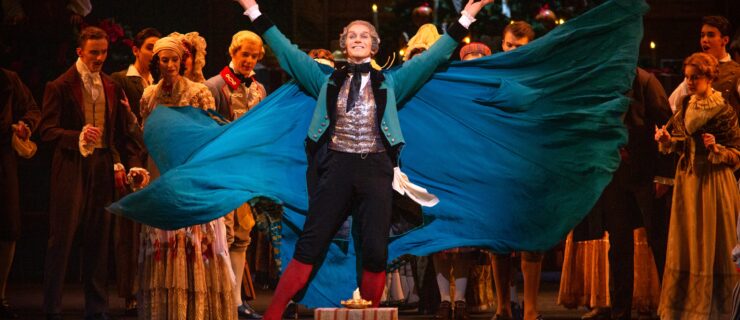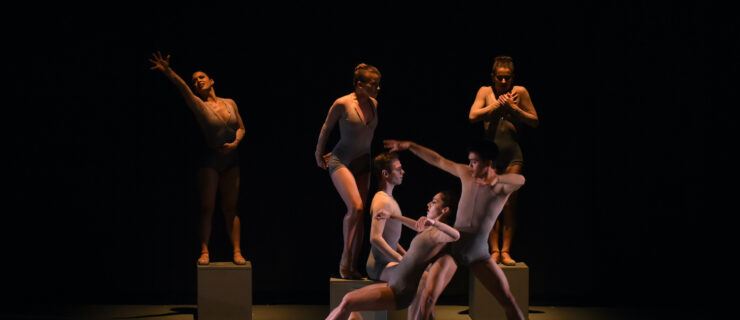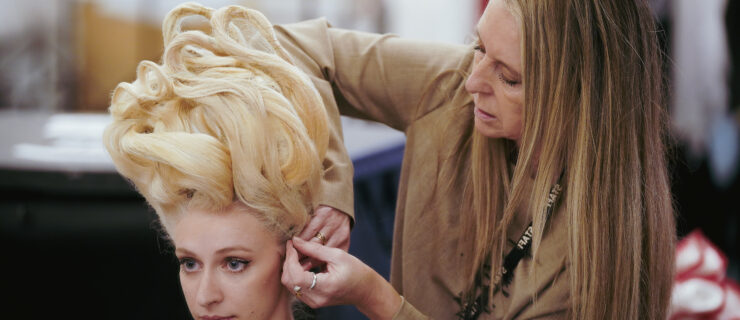A Ballerina Grows in Charlotte
North Carolina Dance Theatre’s Traci Gilchrest didn’t always command the sublime confidence that makes her the versatile and emotionally captivating dancer she is today. “Early on, Traci didn’t fully trust herself,” says Jean-Pierre Bonnefoux, the company’s artistic director. Both Gilchrest and Bonnefoux agree that her turning point came about three years into her tenure with the company, when she was cast in three demanding, and completely different, roles in a single program.
During that high-risk opening night, Gilchrest found her power. She was featured on pointe in the demanding William Forsythe piece, In the Middle, Somewhat Elevated, barefoot in Paul Taylor’s Esplanade and in high heels in George Balanchine’s Slaughter on Tenth Avenue. “I remember thinking, ‘If I can get through this, I will be a better dancer,’” she recalls, laughing. According to Bonnefoux, she was a knockout in all three roles.
“I was so happy. That’s just what I want to do as a dancer,” she says. “It’s easy for dancers to want to be safe. I’m here to dance—I don’t see the point in resting or taking it easy.”
Finding what you are looking for as a dancer can be a challenge. Nearly every young artist may think first of dancing in the “Big City,” but fortunately, as Gilchrest found, the country is dotted with excellent mid-sized companies where dancers can have adventurous ballet careers. NCDT, in the business and banking hub of North Carolina’s largest city, Charlotte, is one of the best of them. Thanks to the company’s aesthetic excellence, non-hierarchical ensemble structure and amazing repertoire, she found her artistic home.
Gilchrest, now 35, was born in El Paso, Texas, and began studying jazz and tap at age 10. She saw the movie Staying Alive and immediately wanted to star on Broadway. “I wasn’t great, but I loved it,” she says of her early hoofing. Her teacher told her that she also had to study ballet. Not enthused, she agreed to take a summer course if it would help her get to Broadway.
To her surprise, ballet suited her completely. When she was told she needed a more serious teacher, she went to Ingeborg Heuser, who also taught at The University of Texas at El Paso. Gilchrest trained in Heuser’s studio until she went to Texas Christian University on scholarship. After a year there, she joined the Hartford Ballet as an apprentice. She was planning to return to college as the apprenticeship ended, when Phoenix-based Ballet Arizona offered her a contract. “It was too good to be true, so I took it,” she says. “Sometimes what comes up is not what you had planned at all, but you just have to go with it.”
Gilchrest stayed with the company in Arizona for four years. While there, she heard about the summer program at Chautauqua Institute in upstate New York and its Chautauqua Ballet, and applied to work there during BA’s off-season. She sent her performance video and got a polite no-thanks letter. The next year, however, Bonnefoux, who directs the Chautauqua Ballet, called to invite her to the company. Two summers later, Bonnefoux offered Gilchrest a position with North Carolina Dance Theatre, where he had been named artistic director. After finishing out her contract with Ballet Arizona, she moved to Charlotte in 1997. She has now danced 14 summers at Chautauqua and is in her 12th season in Charlotte.
Even though it is far in every way from her Southwest birthplace, and equally far from the glamour of New York, Gilchrest now calls Charlotte home. “I think you have to find a place that appreciates you and stick with it.” In a way, she says, committing to a company is like a marriage. “There will be ups and downs, but you know you’ve found your match, and can move ahead and grow.
“It’s a possibility that I would go elsewhere, but I’d love to stay here. I love the city; I have a house here.” Although she is now in the peak years of her career, with audiences who enthusiastically appreciate her artistry, she’s also thinking a step ahead.
Bonnefoux is “very good about integrating retired dancers into the company in other ways,” she says. (Several former dancers are now in teaching and administrative positions, and Gilchrest herself teaches in the NCDT School of Dance.) But whatever may happen in the future, she is “very happy to have a director who appreciates what I’m bringing,” she says. “Everyone here is unique, and the company really showcases that.”
Like most performers, Gilchrest thrives on the adrenaline rush that comes onstage. But what drives her through the daily difficulties is the thrill of the chase. “You have an idea of perfection,” she says, “so you are always trying to reach the unreachable. It’s never going to be perfect, or easy, and you’ll never be satisfied. If I ever had a perfect show, I don’t think I’d want to do it again.”
Gilchrest’s pursuit of perfection takes several routes. She delves into her roles, transforming herself in each. Says Bonnefoux, “She trusts and gives herself to the choreographer—she becomes a Paul Taylor dancer, for instance, or a Dwight Rhoden dancer.” Her conception of a role is not a fortress that the choreographer or the director has to penetrate, adds Bonnefoux. “There’s always room for more information, and it is always welcome.”
Bonnefoux appreciates her work ethic as well. “She has really adapted and improved her body as a tool for dancing,” he says. “Some newly professional dancers get slack about coming to class, especially if they’ve just left school. Instead of a feel-good thing, for Traci, class is something that will produce results.” Gilchrest is a role model in this regard. Despite her years with the company, she’s one of the first to arrive and warm up before class, and she always rehearses full out.
Over the years Gilchrest has learned to take good care of her body. In addition to company class and rehearsals, she also has a daily yoga practice. Whenever possible, she hikes in the mountains, and enjoys walks with her dog. When it comes to nutrition, she has learned the hard way.
“When I was younger, I drank a lot of soda, and that is so bad for you. You can do it, but you’ll feel it by your mid-20s,” says Gilchrest, who also stays away from fast food. “I cook all the time. One of the ways I relax at night is by cooking dinner.” Along with making sure she hydrates with plenty of water, she takes a banana and yogurt with her to class every day.
“If you want a career and not just five years of dancing, you need to start thinking about how you are treating your body. You need to think about what goes into it and how you want it to look in 10 years.”
A dancer’s career “goes so fast,” Gilchrest says. “It is not an easy life, physically, mentally or emotionally. There is something both beautiful and frightening about dedicating your life to the two minutes or two hours of performance for three or four shows. And it’s not all exciting new ballets—you have to inspire yourself with personal challenges. You have to be strong to survive the years. But it is completely worth it.”
Kate Dobbs Ariail has written widely on the arts and culture since 1988 and is the dance critic for the online journal
Classical Voice of North Carolina. She lives in Durham, NC, and Washington, DC.





